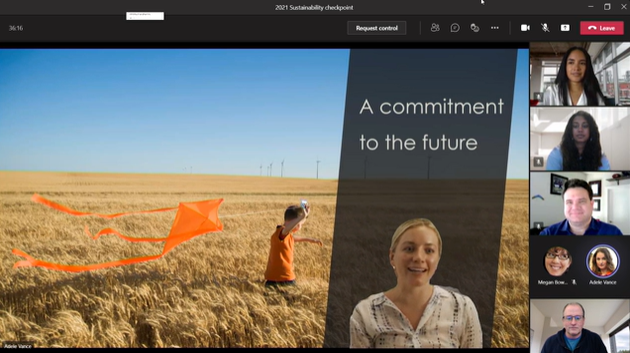Highlights of Microsoft Inspire 2021, Satya Nadella’s Microsoft Cloud Keynote

Following the pandemic, there’s no going back to digital adoption levels from two years ago; there’s only going forward. And the future is the Microsoft Cloud. This sentiment was at the core of Satya’s keynote to kick off Microsoft Ignite 2021. He continually expressed that Microsoft’s aim is to foster innovation by providing teams everywhere with the tools they need to get work done.
It’s clear that Microsoft is investing more into the cloud than ever before, and that came through clear as day during the keynote. Whether it was about how the Microsoft cloud allows users to build digital capability with independence and sovereignty, leverage core integration across the technology stack, or take advantage of strides in AI, the cloud is here to help improve time to value, reduce cost, and increase agility.
Read on for some of the most important highlights from Satya’s opening speech. If you’re hungry for more, you can watch the full VOD here.
Digital Infrastructure
Coming out of this pandemic, one thing is clear: every organization will need more ubiquitous and decentralized computing power. We’re going through radical changes in the computing architecture across the cloud that’ll impact every business. Satya asserted that the Microsoft Cloud is the only cloud with the capability to support every business’ multi-cloud, hybrid, and edge needs in this environment.
As part of Microsoft’s broad goal to expand hybrid capabilities so organisations can build, manage, and deploy their applications anywhere, Azure Arc is a key component. It extends the Azure control plane across on-premises, multi-cloud, and the edge. Azure application services can run anywhere with Azure Arc, so anyone can take their favourite Azure application services wherever they need to. Read more on Azure Arc here.
Data and AI
Every business needs to become digitally sovereign over its own data. The amount of data created over the next three years will be more than the data created over the past 30 years.
Every organization has the opportunity to ensure its data is being used for its benefit. Satya emphasized that the Microsoft cloud is the only cloud that helps you build sovereignty over your own data and customer relationships. Azure Synapse is at the core of this, like so:
- With Synapse Link you can integrate your operational data stores on a real-time basis with your analytics stack.
- With Azure Machine Learning you can build advanced AI models to identify trends and predict outcomes.
- With Power BI an entirely new generation of SaaS operations is being created.
- Dynamics 365 Customer Insights paired with Synapse provide a 360-degree view of your customers with the ability to turn insights into action in real-time.
Developer Tools
Satya harped on the need to expand access to skills, tools, and platforms, as well as connections and collaboration across communities so everyone can create. Be it building virtual worlds, students working on assignments with short-form videos, knowledge workers creating formulas and spreadsheets, pro developers writing code, or domain experts using local tools to build applications, the democratization of creation is essential.
Application development isn’t just about professional developers; it includes domain experts, designers, marketing, sales, customer service, and other vital parts of these teams. To that point, Microsoft Cloud is the only cloud that provides a developer toolchain for everyone across all platforms no matter if it’s Azure, Windows, or any other cloud or client platform. From Visual Studio (25 million monthly users) to Github (65 million monthly users), they have the most popular tools to help devs go from idea to code and code to cloud.
Satya then touched on Microsoft Power Platform, which Microsoft is touting as a next-generation business process automation and productivity suite that’s being used by nearly 16 million monthly active users at the time of writing. People have been able to use Power Platform to build apps and workflows for everything from COVID-19 screenings to product quality control.
Closing out this section, Microsoft announced that in the spirit of enabling collaboration, Teams customers will receive access to Dynamics 365 data within Microsoft Teams at no extra cost regardless of whether they have a Dynamics 365 licensee.
Hybrid Work
When we talk about structural change, hybrid work represents the largest change since the adoption of the 9-5 workday over a century ago. Hybrid requires a new operating model, and productivity will need to be defined much more inclusively of collaboration, learning, and wellbeing. It’s all about being flexible in terms of where, when, and how people work.
Naturally, Microsoft Teams plays a huge role here. Satya noted that Teams currently has 145 million daily active users, almost double what it had a year ago. Over the last 18 months they’ve introduced over 300 new features to the platform, from new presenter modes for more intuitive presentations (pictured above) to new meeting layouts to make it feel like everyone is in the room together.
Then came what’s arguably the most exciting announcement of the entire keynote: Windows 365. This operating system will make Windows available on any device via the cloud. Users will be able to set up a “cloud PC” and stream the full Windows experience from the Microsoft cloud to a personal or corporate device. The goal? to provide greater flexibility and more ways to empower the workforce to be more productive and connected regardless of employee location.
This is notably similar to Microsoft’s strategy with Xbox Game Pass, which has transcended the Xbox console to be playable from the cloud via mobile, browser, and eventually smart TVs.
Industry Transformation
Digital adoption is being accelerated in every industry. Today we talk about remote learning, sales, and manufacturing, but eventually it’ll just be referred to as learning, sales, and manufacturing.
Over the past year, Microsoft has introduced industry clouds for financial services, healthcare, manufacturing, non-profits, and retail. Well, Satya took the start of Microsoft Inspire to announce a new cloud: Microsoft Cloud for Sustainability.
This new cloud will apply to every industry and was created in response to the continued requests for greater accountability and more rapid progress on carbon reduction efforts. Microsoft is bringing together capabilities across their cloud to create a new business process category to help every organization address this critical need.
And those are all the major points from this year’s Microsoft Inspire keynote! More than ever, it’s crystal clear that Microsoft is all-in on the cloud, and they continue to innovate at an alarming rate. If you want to watch the whole presentation yourself and pick up any details we didn’t cover here, give the full session a watch!
Originally published at https://www.avepoint.com/blog/office-365/microsoft-cloud-inspire/


